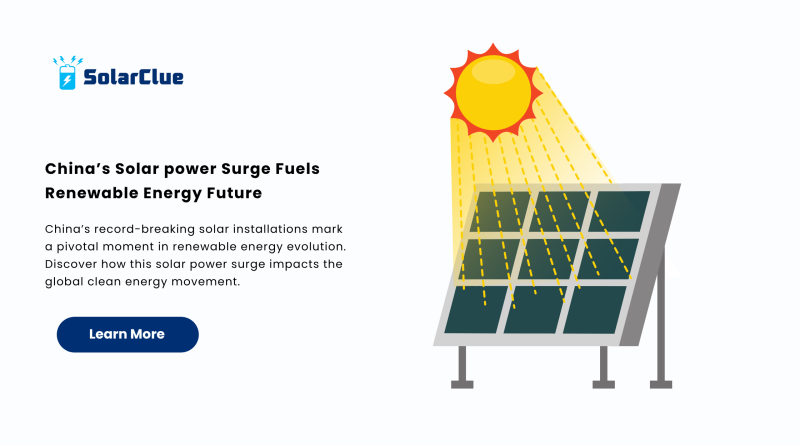China’s Solar power Surge Fuels Renewable Energy Future
In an astonishing leap for the energy sector, China recently installed a record-breaking 93 gigawatts (GW) of solar capacity in just one month—May 2025. This figure surpasses the total annual solar installations of most countries, underlining China’s determination to dominate the global renewable energy market. This moment, often referred to as the China Solar Power Surge, marks a significant shift not just in China’s energy infrastructure but in the global pursuit of clean energy.
Table of Contents
- 1 Understanding the China Solar Power Surge
- 2 Why China Rushed to Expand Solar So Fast
- 3 What This Means for the Global Renewable Energy Landscape
- 4 The Challenges Behind the Achievement
- 5 India’s Renewable Energy Scheme: Lessons to Learn
- 6 Why Policy Matters in Solar Adoption
- 7 Technological Advances in Solar Power Systems
- 8 Economic and Environmental Advantages
- 9 How Homeowners Can Benefit from Solar Today
- 10 SolarClue: Your Guide in the Solar Journey
- 11 What’s Next for Renewable Energy?
- 12 Conclusion: A Bright Future for Solar and Clean Energy
- 13 FAQs
Understanding the China Solar Power Surge
The term China Solar Power Surge encapsulates the explosive growth of solar power systems across the country. According to data from the National Energy Administration, this 93 GW installation beats the previous record of 71 GW set just a few months earlier in December 2024. To grasp the scale, this one-month surge is more than the full-year solar capacity installed by any other nation in 2024. This achievement highlights China’s unmatched commitment to transitioning towards solar energy and reducing its reliance on fossil fuels.
Why China Rushed to Expand Solar So Fast
The driving force behind this surge lies in a strategic policy shift. Up until June 1, 2025, solar power projects in China benefited from government-backed pricing protections that ensured profitability. With this scheme ending, developers raced to complete their projects before the deadline. Additionally, a new policy implemented on May 1 made it harder to connect rooftop solar panels to the grid, further incentivizing early installation. The combination of policy expiration and grid challenges led to a mad dash to deploy solar panels across the nation.
What This Means for the Global Renewable Energy Landscape
China’s bold move sends a clear message: the future belongs to renewable energy. Other countries now face increasing pressure to scale up their efforts in clean energy development. While China’s pace may not be sustainable month-over-month, the 93 GW benchmark has redefined what’s possible. As a result, we’re likely to see more aggressive solar expansion strategies globally—especially from emerging markets like India and Brazil.
The Challenges Behind the Achievement
Despite its scale, the China Solar Power Surge comes with complications. Overcapacity is a major concern. China’s solar panel manufacturers are struggling due to plummeting prices and intense competition. Many top manufacturers reported losses in the first quarter of 2025, a trend driven by price wars and trade tensions with global markets. There’s an urgent need for consolidation in the manufacturing sector to prevent a race to the bottom.
India’s Renewable Energy Scheme: Lessons to Learn
India, another major player in the renewable energy scheme, has much to learn from China’s experience. While India has made strides in solar energy, it still lags behind in infrastructure readiness and policy coordination. With proper planning, India can avoid the pitfalls of overcapacity and focus on sustainable solar power system deployment that benefits both the economy and the environment.
Why Policy Matters in Solar Adoption
Strong, well-timed policy is the backbone of successful solar installations. China’s rapid growth was made possible through incentivized pricing and government-backed support. However, without long-term planning, such booms can lead to market instability. Other countries should adopt policies that encourage steady, scalable, and sustainable solar expansion.
Technological Advances in Solar Power Systems

Technological innovation continues to enhance the efficiency and affordability of solar power systems. From high-efficiency panels to AI-powered energy management, the next generation of solar energy solutions promises better grid integration and user-friendly systems. These advancements are critical for meeting rising global energy demands.
Economic and Environmental Advantages
The environmental benefits of switching to clean energy are well-documented. Reduced carbon emissions, cleaner air, and lower dependence on fossil fuels are just the beginning. On the economic side, solar installations generate jobs across manufacturing, installation, maintenance, and R&D. Energy independence also contributes to national security and economic resilience.
How Homeowners Can Benefit from Solar Today
For homeowners and small businesses, now is the perfect time to consider installing a solar panel system. With improving technology and increasing availability of subsidies, the upfront cost is more manageable than ever. Consumers can significantly cut down their energy bills and reduce their carbon footprint by switching to solar energy.
To learn more about how solar can transform your home and your savings, explore solarclue.com, a platform offering trusted solar solutions tailored to your location and needs.
SolarClue: Your Guide in the Solar Journey
Whether you’re curious about system sizing, government subsidies, or future tech, blog.solarclue.com is an invaluable resource for staying up to date on the latest in solar and renewable energy trends. From DIY guides to deep industry insights, it’s the go-to hub for solar enthusiasts and professionals alike.
What’s Next for Renewable Energy?
As the dust settles after the China Solar Power Surge, the world is watching to see if this pace can be matched—or even maintained. New policies in China may slow installations temporarily, but the foundation has been set for long-term transformation. The future of renewable energy looks brighter than ever, with solar playing a leading role.
Conclusion: A Bright Future for Solar and Clean Energy
China’s May 2025 record stands as a symbol of what’s possible when ambition, policy, and technology align. While challenges remain, the momentum built from this milestone is already spreading across borders. As countries, companies, and consumers all strive for a cleaner future, one thing is clear: the sun is rising on a new era of clean energy.
So, whether you’re a policymaker, an entrepreneur, or just someone looking to save on electricity bills, now is the time to explore what solar power can do for you. Start your solar journey today at solarclue.com, and dive deeper into expert knowledge at blog.solarclue.com. The future is solar—don’t be left in the dark.
FAQs
1. What led to China’s recent solar installation surge?
The surge was driven by a rush to complete projects before new regulations removed pricing protections for solar power, alongside increasing difficulty in grid connection for rooftop systems.
2. Will China continue expanding solar at this pace?
While May 2025 was exceptional, growth is expected to moderate due to policy shifts. However, long-term expansion remains a national priority.
3. How does solar energy benefit the environment?
Solar energy produces no emissions during operation, reducing carbon footprints and air pollution, and contributing to a sustainable future.
4. Is solar power affordable for homeowners?
Yes. With falling prices, better technology, and government incentives, installing solar panels has become more affordable than ever.
5. What is the future of renewable energy globally?
The global outlook is optimistic, with investments rising in solar, wind, and other renewable energy sectors. Policy and innovation will drive further growth.




